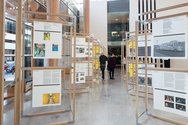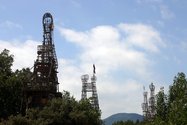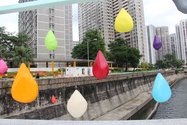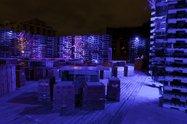John Hurrell – 2 July, 2015
I imagine it is a very difficult task to select or evaluate such projects, firstly on the basis of documentation and then relying on spoken presentations. You'd think ‘social engagement' as an art species would be crystal clear as a category, but yet, when you think about it and look closely here, it is still pretty vague.
Auckland
International group show (part of Cities in a Climate of Change conference)
The 2015 International Award for Public Art
27 June - 6 July 2015
In this exhibition of descriptions and images of ‘socially engaged’ artworks presented in Auckland Art Galley’s north atrium, we see fifteen freestanding boxshaped frames: three rows of five. On both sides of each wooden structure are hung accounts of (mostly but not all) community focussed artworks - plus there are two introductions on the end walls. Initially a hundred and fifty were researched and proposed, and then thirty-two were selected. From these seven finalists were picked.
So this show presents written descriptions and photographs of the rejected semi-finalists, mingled with the chosen final seven, who yesterday gave talks on their work at the Cities in a Climate of Change conference, hosted by the University of Auckland. The two most well known artists of the whole assortment are probably Alfredo Jaar and Susan Philipsz, though Christchurch group Gap Filler have a high profile now, and Sreejata Roy in Delhi was interviewed by Mercedes Vicente within a touring show a couple of years ago. If you want to look at these semi-finalists (all of them) click here. For the seven finalists (now visiting Auckland), click on this.
To compete for this award - which was won by Jasmeen Patheja with Talk to Me, and announced last night - the finalists provided documentation in a public talk. Like the visitors to this exhibition, the panel of judges listening to the presentations, didn’t of course experience the work directly - a problem in my view because I personally prioritise the experiential, though here obviously it is not possible.
I imagine it is a very difficult task to select or evaluate such projects, firstly on the basis of documentation and then relying on spoken presentations. You’d think ‘social engagement’ as an art species (1) would be crystal clear as a category, but yet when you think about it and look closely here, it is still pretty vague. After all, all sorts of pertinent criteria are possible in the mix, such as: the amount of suffering ameliorated; the long term benefits versus short; the political support for its results; the size of community affected; the geographic location of each project, in terms of access to global media; the geographic location of project, in terms of perceived exoticism; the confidence and charisma of the presenters; the poetic and/or ethical dimension of the work (it’s hold on the public imagination). That is why when you look closely at the semi finalists, it is hard to find a common attribute. Collectively the finalists are more cohesive.
If so inclined you can visit Auckland Art Gallery Toi o Tamaki and peruse the slightly awkward presentation there, or you can investigate the very informative links provided above, from where you are now. Both are limited by what they openly are: documentation and written descriptions. There is no immersive sound, smell or jostling visual tactility. Only antiseptic photographs and text. Interesting projects in a clinical presentation that are a teeny-weeny taste, not a substitute for a direct encounter.
John Hurrell
(1) My own inclinations are that ultimately social engagement or community involvement is irrelevant to quality in art. The very best art (by that I mean the most ‘superduper interesting’ in terms of new methods of creating meaning), I think involves a playful messing around with media, a semiotic layering or systematic juxtaposition where different symbolisms embodied in materials and generic codes are violently crashed, jammed together or wrenched apart. Examples of artists who have done this include Richard Prince, Eric Cameron, Ceal Floyer, Douglas Gordon and Frances Stark.
Recent Comments
John Hurrell
Thanks Daniel. I appreciate you telling me so I can correct it.
Daniel Newnham
I think the word look is missing from 2nd to last sentence, paragraph 4.









 Two Rooms presents a program of residencies and projects
Two Rooms presents a program of residencies and projects Advertising in this column
Advertising in this column



This Discussion has 2 comments.
Comment
Daniel Newnham, 4:22 p.m. 2 July, 2015 #
I think the word look is missing from 2nd to last sentence, paragraph 4.
John Hurrell, 8:48 p.m. 2 July, 2015 #
Thanks Daniel. I appreciate you telling me so I can correct it.
Participate
Register to Participate.
Sign in
Sign in to an existing account.